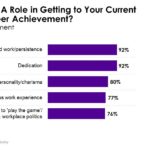
It would be easy to consider the value of a career path solely in terms of its destination, but having a known and promising journey has standalone value. We all know how the anticipation of an event can be just as joyful as the event itself, and we’ve heard senior citizens reflect on how they might have handled their time and journey differently if they could relive their life. It’s time to take the career path more seriously and to give it serious attention.
When we look at the relationships between career satisfaction and the assessment of various aspects of a career, we see that the most important aspect is not reaching the highest possible position. Instead, satisfaction is driven most by having a promising career path, followed by having internal support to advance and having achievable goals and aspirations.
Last fall, WIPN and Escalent embarked on a first-of-its-kind assessment of the attitudes, experiences, behaviors and compensation of women in the retirement industry. When exploring women’s career paths, we unfortunately see that only half (51%) agree that their career path looks promising, representing one of the largest gaps in this research between defining and achieving success. If employers don’t value this finding for altruistic reasons, then they should certainly pay attention for retention ones: two in five women have considered leaving over the past year due to a lack of opportunities for advancement, and one in five have considered leaving often.
When thinking about the career path, pay attention to available opportunities, support, training and transparency.
Available opportunities and support
Only half of women in the retirement industry agree they have the support needed inside their company to advance. More than one-quarter believe advancing is harder as a woman, and for women of color, this drops to two in five. These challenges are particularly threatening when we consider the one in four who believes a lack of available opportunities is the biggest barrier to success.
While it would be easy to react to this by encouraging women to make their own opportunities or leave, this is a hefty burden for an individual. Removing this female advancement handicap and supporting support are critical in retaining women talent and developing clear career paths for them.
Training
Similarly, lack of training is another reason women have trouble staying on a promising career path even when it does exist. One in five women in the retirement industry names “gaining a new skill” as a top factor that makes her feel successful, but one in three believes she does not have the education and/or training needed to advance. When considering the additional time required of women in the home and the effort put forth changing who they are at work—supported by these research outcomes—training has to be available in many flexible forms and within the boundaries of the workplace.

Pathway transparency
Embedded in this idea of career progression is that not only is advancement possible, the way to achieve it is transparent. Everyone needs to be playing the same game. This is important to women and particularly important to women of color. “Charisma” and “navigating workplace politics” are two of the five biggest contributors to the overall level of career achievement of women in the industry. An inability to navigate workplace politics ranks second on the list of barriers to success at work. A documented career pathway supports positive outcomes but also protects against negative ones for employers and employees.
“It took me much longer to get to my pay level than others. I feel like many factors were involved, but being a female didn’t help. I wasn’t part of the boys club when managers were looking to promote or pass clients down. I had to prove every bit of my skill, talent and professionalism over and over again to gain the respect that I deserved the whole time.” – GenXer
Role played in getting to current level of career achievement

They say to “forge your own path!” “Lean in!” “Create your own luck!” “Don’t settle!” This is all well and good, but it’s an outsized success story when a woman can overcome the multifaceted barriers she faces. It’s a simple but important ask to know the road you’re on, how to navigate it, and that navigating it is possible. This provides a clear impetus to employers to stop underestimating the importance of establishing this career pathway. On a recent podcast with Advisor2X, Ross Marino thoughtfully notes this isn’t as easy as it sounds when it comes to smaller businesses. As with many aspects of career growth, the path can change, but this research argues that the criticality is worth the effort to create a starting point.
For a deeper look at the attitudes and behaviors of women in the retirement industry, download our joint white paper with WIPN, What’s Working at Work.









